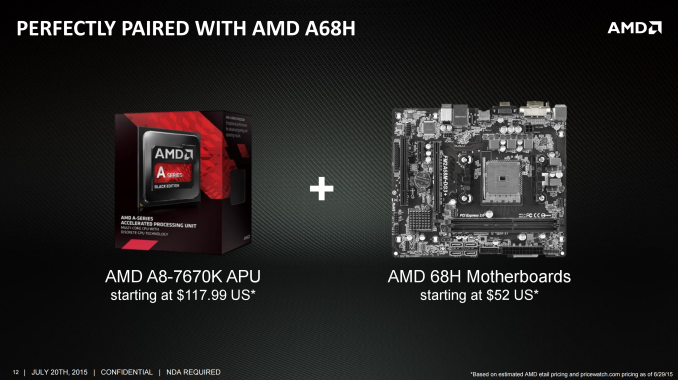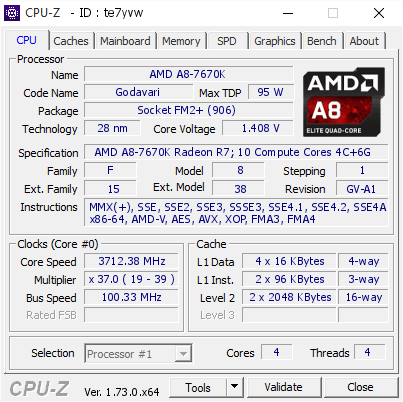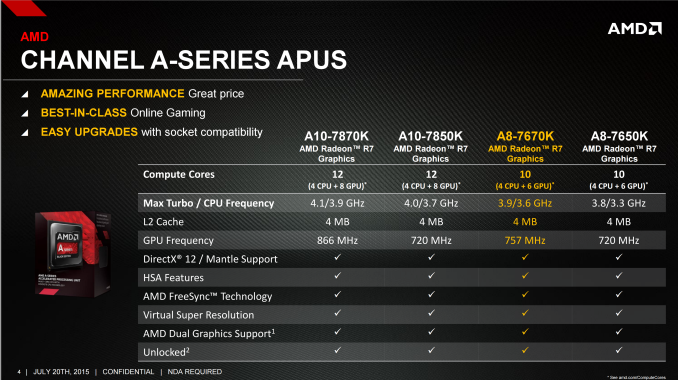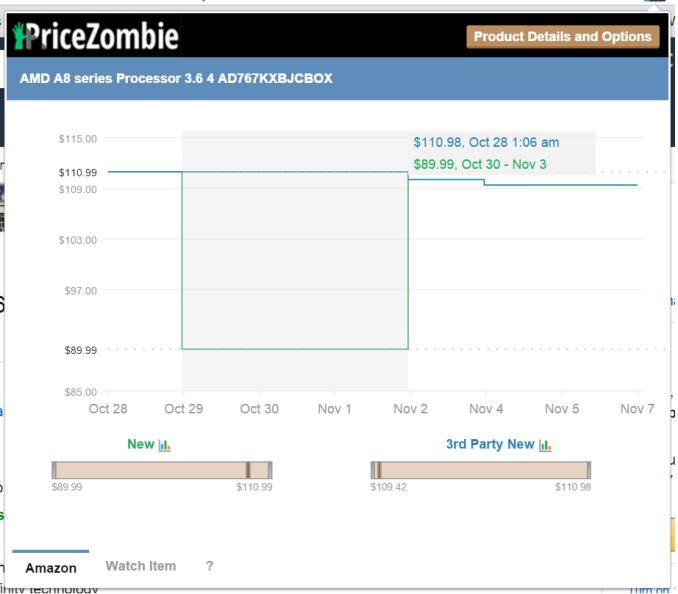The AMD A8-7670K APU Review: Aiming for Rocket League
by Ian Cutress on November 18, 2015 8:00 AM EST
Over the past couple of years, AMD has slowly released their mainstream brand of Kaveri processors. In turn, we have reviewed them, and they consistently aim to provide a midrange integrated gaming option, especially for those on a budget. The recent release of the A8-7670K was perhaps not that exciting, as AMD is filling up their product stack with new parts, taking advantage of an improved manufacturing process and aggressive binning. To that end, we're taking a different tack with this review. Alongside the regular tests, we also corralled Rocket League (an amazingly simple yet popular take on car football/soccer that sits on the precipice of e-sports glory) into a benchmark aimed at those sub-$600 gaming systems.
The AMD A8-7670K
Earlier this year, AMD announced their new line of Kaveri Refresh processors, starting with the A10-7870K (which we reviewed here). As the name suggests, these are Kaveri processors at their core, still based on the combination of Steamroller processor cores and 2nd generation Graphics Core Next (GCN) microarchitecture for graphics. These new refresh models are designed to take advantage of minor improvements in manufacturing, resulting in the ability to get higher clock speed for the same power consumption, even 18 months after the first Kaveri processors hit the scene. As a result, these Refresh processors — or, to use AMD's internal code name, "Godavari" — fill in the blank spots in the product stack and supersede the older parts, with the aim of squeezing in more frequency and performance for the same power consumption. It sounds deceptively simple — improve your process, refresh the part at the same price, and reap the benefits.
If we look at AMD's current lineup, we see that this new A8-7670K surpasses the older A10-7700K on the specification sheet, and comes in cheaper when brand-new.
| AMD Kaveri Lineup | ||||||||
| A10- 7870K |
A10- 7850K |
A10- 7800 |
A10- 7700K |
A8- 7670K |
A8- 7650K |
A8- 7600 |
X4 860K |
|
| Price | $137 | $134 | $131 | $120 | $118 | $104 | $89 | $85 |
| Modules | 2 | 2 | 2 | 2 | 2 | 2 | 2 | 2 |
| Threads | 4 | 4 | 4 | 4 | 4 | 4 | 4 | 4 |
| Core Freq. (GHz) | 3.9-4.1 | 3.7-4.0 | 3.5-3.9 | 3.4-3.8 | 3.6-3.9 | 3.3-3.8 | 3.1-3.8 | 3.7-4.0 |
| Compute Units | 4+8 | 4+8 | 4+8 | 4+6 | 4+6 | 4+6 | 4+6 | 4+0 |
| Streaming Processors |
512 | 512 | 512 | 384 | 384 | 384 | 384 | N/A |
| IGP Freq. (MHz) | 866 | 720 | 720 | 720 | 754 | 720 | 720 | N/A |
| TDP | 95W | 95W | 65W | 95W | 95W | 95W | 65W | 95W |
| DRAM Frequency |
2133 | 2133 | 2133 | 2133 | 2133 | 2133 | 2133 | 1866 |
| L2 Cache | 2x2MB | 2x2MB | 2x2MB | 2x2MB | 2x2MB | 2x2MB | 2x2MB | 2x2MB |
As it stands, the A8-7670K is a dual-module 3.6 GHz base frequency processor with a boost frequency up to 3.9 GHz. It comes with six graphics compute units, which translates to 384 streaming processors, similar to other A8 parts, but at a slightly higher IGP frequency of 754 MHz. The combined increase in processor and integrated graphics frequencies come at no extra cost in thermal design, with the A8-7670K at the same 95W TDP.
One of AMD's marketing strategies with these ~$100 processors is the price/performance angle. Aside from the integrated graphics, each of the AMD processors can pair with an R7 240 or R7 250 graphics card (DDR3 or GDDR5; AMD suggests an R7 250 GDDR5, as you might expect) in a hybrid dual graphics scenario, boosting performance. Thus, for the same price as an APU and an R7 250 graphics card, on average, AMD aims to offer a better gaming experience — especially for games that run at around 60 frames per second on medium settings — than a similarly priced Intel + NVIDIA platform. We've seen this marketing spiel corroborated in previous reviews, and would expect not to see anything different here. At launch, AMD put a $118 price on the A8-7670K, which, in recent sales, has been pushed down to under $100 at times.
The A8-7670K is an FM2+ socket processor, and thus requires either an A88X, A85X, A78 or A68 motherboard to go with it in order to take full advantage. As part of the launch, and given that this processor is a slightly boosted A8-7650K, AMD sees value in pairing it with something like a $50 A68H motherboard, making an APU+MB combination around $150 when on sale. However, as one might imagine, due to the age of the FM2/FM2+ socket, there are relatively few "new" motherboards on the market. The last one we reviewed was MSI's A88X-G45 Gaming, which brought over some of the components seen on its new Intel gaming motherboards, but other manufacturers have also put out M.2 capable AMD chipset-based motherboards as well.













154 Comments
View All Comments
BurntMyBacon - Thursday, November 19, 2015 - link
@medi03: "I would point you to the fact that Netburst outsold superior Athlon 64s 4 to 1."True, a superior architecture doesn't guarantee better sales, even at better prices. However, Dribble didn't accuse this solution of being inferior for the market it is targeting. He stated:
@Dribble: "No one is buying, ..." and "... the market isn't there."
I don't entirely agree, though (by CPU sales) the market doesn't seem to be very large and is clearly low margin. These are not the processors that will save AMD's business. Zen will likely be the most important CPU architecture in the company's history (whether the design is good/bad/novel/obvious).
medi03 - Thursday, November 19, 2015 - link
I would point you to the fact that Netburst outsold superior Athlon 64s 4 to 1.JoeMonco - Thursday, November 19, 2015 - link
But your silly *facts* don't matter. [Year+1] with the release AMD [Microarchitecture+1] is gonna finally beat Intel! And I know this because my irrational brand loyalty says so!!barleyguy - Thursday, November 19, 2015 - link
You mocking irrational brand loyalty is irony at its finest. ;-)JoeMonco - Thursday, November 19, 2015 - link
I don't see what the irony is supposed. Criticizing AMD doesn't mean I like Intel. ARM is the only real competition that Intel faces.hojnikb - Thursday, November 19, 2015 - link
How much did you spend on that ram ?I bet you could get pentium+4g of ram and a nice 250X (or even 260x on sale) for around the same money.
Thats the problem with apus. They need fast ram in dual channel to be taken advantage of.
yannigr2 - Thursday, November 19, 2015 - link
An A8 7600 costs only $20-$30 more than a Pentium? 8GBs of 1866-2000MHz costs only $10-$20 more than 8GB 1333Mhz? And the card you get in the APU is a little faster than an R7 240 as the review shows.So, in the end you save $30-$40 for the same if not a tiny better gaming experience. This is HUGE if you don't have the money, or if you are a retail shop that tries to create an ultra cheap system that you can market it as gaming and also have one less part in there that makes the assembly easier and also lowers the possibility of an RMA because of the extra part(the discrete card).
AMD can't sell much, because Intel controls the market, people who don't know about hardware buy the Intel brand and individuals who are asked to help others to build such low cost machines, usually exclude AMD from the beginning without even considering it as an option, or even try as hard as they can to make other avoid AMD's solutions. That's even when AMD's solutions are the perfect solutions for specific cases, and those are the same people who constantly cry about competition. My example in my previous post proves that and it was an example based on a last week's case.
silverblue - Thursday, November 19, 2015 - link
Fast RAM which isn't exactly at a premium anymore... at least, right now. I just took a quick glance at HyperX Savage prices on Amazon and a 16GB (2x8) kit was £64 to £65 for 1600 and 1866MHz, and £68 for 2400MHz, with 2133MHz being a little more still. I know, it's a small sample for a single product range, and a lot of these look to have had massive reductions recently, but right now it's not really an expense going with faster RAM.If you play games that benefit from Hybrid Crossfire, it's an option, certainly more than it used to be, however it's still not at the level that I would consider to be worthwhile outside of that particular scenario, and scaling is still minimal even when it does work (in general).
I would like to know what AMD's current CPU market share is. People are forever saying that nobody is buying AMD, however based on popularity on www.dabs.com it appears that the 860K is the top CPU, with the 8320E in second place. The i3-6100 is in third place.
JoeMonco - Thursday, November 19, 2015 - link
25fps? Is that supposed to be impressive?yannigr2 - Thursday, November 19, 2015 - link
You are wrong. I guess two years ago you would have been absolutely sure that this generation consoles wouldn't sell because the hardware wasn't strong enough to run latest AAA titles at the highest possible settings.